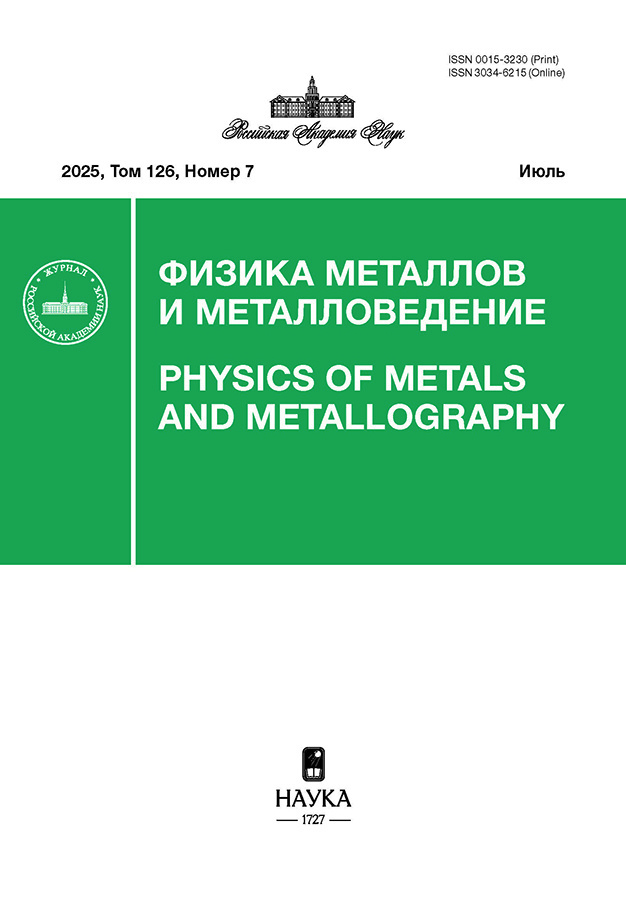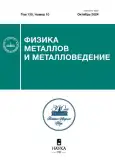Эволюция структуры хромогафниевой бронзы при динамическом канально-угловом прессовании и последующем отжиге
- Авторы: Попов В.В.1, Попова Е.Н.1, Фалахутдинов Р.М.1, Судакова С.А.1, Шорохов Е.В.2, Гаан К.В.2, Атрошкин В.В.2
-
Учреждения:
- Институт физики металлов им. М.Н. Михеева УрО РАН
- Российский федеральный ядерный центр ВНИИ технической физики им. акад. Забабахина
- Выпуск: Том 125, № 10 (2024)
- Страницы: 1264-1273
- Раздел: СТРУКТУРА, ФАЗОВЫЕ ПРЕВРАЩЕНИЯ И ДИФФУЗИЯ
- URL: https://transsyst.ru/0015-3230/article/view/681899
- DOI: https://doi.org/10.31857/S0015323024100087
- EDN: https://elibrary.ru/JFBCYI
- ID: 681899
Цитировать
Полный текст
Аннотация
Изучена эволюция структуры хромогафниевой бронзы при высокоскоростной интенсивной пластической деформации методом динамического канально-углового прессования (ДКУП) и последующем отжиге. Показано, что фрагментация структуры при ДКУП происходит преимущественно по механизму двойникования, особенно при деформации в 2 прохода. При этом происходит существенное упрочнение и микротвердость возрастает до 1750 МПа. При отжиге бронзы наблюдается дополнительное упрочнение за счет выделения частиц Cu5Hf и Cr. Структура бронзы после ДКУП имеет высокую термическую стабильность, максимум твердости достигается после отжига при 400°С. Упрочнение и термическая стабильность структуры в хромогафниевой бронзе выше, чем в гафниевой.
Полный текст
Об авторах
В. В. Попов
Институт физики металлов им. М.Н. Михеева УрО РАН
Автор, ответственный за переписку.
Email: vpopov@imp.uran.ru
Россия, ул. С. Ковалевской, 18, Екатеринбург, 620108
Е. Н. Попова
Институт физики металлов им. М.Н. Михеева УрО РАН
Email: vpopov@imp.uran.ru
Россия, ул. С. Ковалевской, 18, Екатеринбург, 620108
Р. М. Фалахутдинов
Институт физики металлов им. М.Н. Михеева УрО РАН
Email: vpopov@imp.uran.ru
Россия, ул. С. Ковалевской, 18, Екатеринбург, 620108
С. А. Судакова
Институт физики металлов им. М.Н. Михеева УрО РАН
Email: vpopov@imp.uran.ru
Россия, ул. С. Ковалевской, 18, Екатеринбург, 620108
Е. В. Шорохов
Российский федеральный ядерный центр ВНИИ технической физики им. акад. Забабахина
Email: vpopov@imp.uran.ru
Россия, а/я 245, Снежинск, Челябинская обл., 456770
К. В. Гаан
Российский федеральный ядерный центр ВНИИ технической физики им. акад. Забабахина
Email: vpopov@imp.uran.ru
Россия, а/я 245, Снежинск, Челябинская обл., 456770
В. В. Атрошкин
Российский федеральный ядерный центр ВНИИ технической физики им. акад. Забабахина
Email: vpopov@imp.uran.ru
Россия, а/я 245, Снежинск, Челябинская обл., 456770
Список литературы
- Осинцев О.Е., Федоров В.Н. Медь и медные сплавы. Отечественные и зарубежные марки. Справочник. М.: Машиностроение, 2004. 336 с.
- Барабаш В.П., Калинин Г.М. Опыт разработки и практического использования базы данных по свойствам материалов внутри корпусных элементов ИТЭР // Вопр. атомной науки и техники. Сер. Материаловедение и новые материалы. 2006. Вып. 2(67). С. 450–458.
- Беляева А.И., Коленов И.В., Савченко А.А., Галуза А.А., Аксенов Д.А., Рааб Г.И., Фаизова С.Н., Войценя В.С., Коновалов В.Г., Рыжков И.В., Скорик О.А., Солодовченко С.И., Бардамид А.Ф. Влияние размера зерна на стойкость к ионному распылению зеркал из низколегированного медного сплава системы Cu–Cr–Zr // Вопр. атомной науки и техники. Сер. Термоядерный синтез. 2011. Вып. 4. С. 50–59.
- Зельдович В.И., Фролова Н.Ю., Хомская И.В., Хейфец А.Э. Электронно–микроскопическое исследование старения в сплаве Cu-0.06% Zr // ФММ. 2016. Т. 117. № 7. С. 732–741.
- Khomskaya I.V., Zel’dovich V.I., Frolova N.Y., Abdullina D.N., Kheifets A.E. Investigation of Cu5Zr particles precipitation in Cu-Zr and Cu-Cr-Zr alloys subjected to quenching and high strain rate deformation // Letters on Materials. 2019. V. 9. No. 4. P. 400–404.
- Бродова И.Г., Зельдович В.И., Хомская И.В. Фазово-структурные превращения и свойства цветных металлов и сплавов при экстремальных воздействиях // ФММ. 2020. Т. 121. № 7. С. 696–730.
- Абдуллина Д.Н., Хомская И.В., Разоренов С.В., Шорохов Е.В. Динамические свойства низколегированных сплавов меди с субмикрокристаллической структурой, полученной высокоскоростной деформацией // ФММ. 2023. Т. 124. № 12. С. 1279–1287.
- Dobatkin S.V., Shangina D.V., Bochvar N.R., Janecek M. Effect of deformation schedules and initial states on structure and properties of Cu-0.18% Zr alloy after high-pressure torsion and heating // Mater. Sci. Eng. A. 2014. V. 598. P. 288–292.
- Purcek G., Yanar H., Shangina D.V., Demirtas M., Bochvar N.R., Dobatkin S.V. Influence of high pressure torsion-induced grain refinement and subsequent aging on tribological properties of Cu–Cr–Zr alloy // J. Alloys and Compounds. 2018. V. 742. P. 325–333.
- Wongsa-Ngam J., Kawasaki M., Langdon T.G. The development of hardness homogeneity in a Cu-Zr alloy processed by equal-channel angular pressing // Mater. Sci. Eng. A. 2012. V. 556. P. 526–532.
- Zhilyaev A.P., Morozova A., Cabrera J.M., Kaibyshev R., Langdon T.G. Wear resistance and electroconductivity in a Cu-0.3Cr-0.5Zr alloy processed by ECAP // J. Mater. Sci. 2017. V. 52. P. 305–313.
- Зельдович В.И., Добаткин С.В., Фролова Н.Ю., Хомская И.В., Хейфец А.Э., Шорохов Е.В., Насонов П.А. Механические свойства и структура хромоциркониевой бронзы после динамического канально-углового прессования и последующего старения // ФММ. 2016. Т. 117. № 1. С. 74–82.
- Khomskaya I.V., Zel’dovich V.I., Frolova N. Yu., Kheifets A.E., Shorokhov E.V., Abdullina D.N. Effect of high-speed dynamic channel angular pressing and aging on the microstructure and properties of Cu–Cr–Zr alloys // IOP Conf. Ser.: Mater. Sci. Eng. 2018. V. 447. P. 012007 (6 pp.).
- Хейфец А.Э., Хомская И.В., Коршунов Л.Г., Зельдович В.И., Фролова Н.Ю. Влияние высокоскоростной деформации и температуры старения на эволюцию структуры, микротвердость и износостойкость низколегированного сплава Cu–Cr–Zr // ФММ. 2018. Т. 119. № 4. С. 423–432.
- Shangina D.V., Bochvar N.R., Dobatkin S.V. The effect of alloying with hafnium on the thermal stability of chromium bronze after severe plastic deformation // J. Mater. Sci. 2012. V. 47. P. 7764–7769.
- Shangina D.V., Gubicza J., Dodony E., Bochvar N.R., Straumal P.B., Tabachkova N. Yu., Dobatkin S.V. Improvement of strength and conductivity in Cu-alloys with the application of high pressure torsion and subsequent heat-treatments // J. Mater. Sci. 2014. V. 49. P. 6674–6681. https://doi.org/10.1007/s10853–014–8339–4
- Dobatkin S.V., Bochvar N.R., Shangina D.V. Ageing processes in ultrafine-grained low-alloyed bronzes subjected to equal channel angular pressing // Adv. Eng. Mater. 2015. V. 17. No. 12. P. 1862–1868.
- Shangina D., Maksimenkova Yu., Bochvar N., Serebryany V., Raab G., Vinogradov A., Skrotzki W., Dobatkin S. Influence of alloying with hafnium on the microstructure, texture and properties of Cu–Cr alloy after equal channel angular pressing // J. Mater. Sci. 2016. V. 51. P. 5493–5501.
- Попов В.В., Попова Е.Н., Столбовский А.В., Фалахутдинов Р.М., Мурзинова С.А., Шорохов Е.В., Гаан К.В. Влияние исходной обработки на структуру гафниевой бронзы при высокоскоростном прессовании // ФММ. 2020. Т. 121. № 5. С. 501–508.
- Фалахутдинов Р.М., Попов В.В., Попова Е.Н., Столбовский А.В., Шорохов Е.В., Гаан К.В. Влияние исходного состояния на эволюцию структуры гафниевой бронзы при старении // ФММ. 2022. Т. 123. № 9. С. 962–970.
- Диаграммы состояния двойных металлических систем: Справочник: В 3 т.: Т. 2. Под общей ред. Н.П. Лякишева. М.: Машиностроение, 1996. 1024 с.
Дополнительные файлы



















